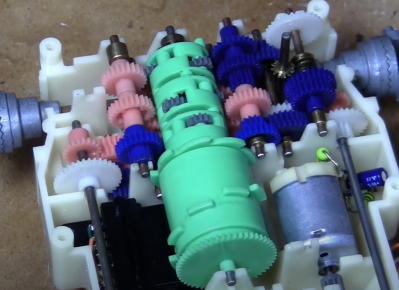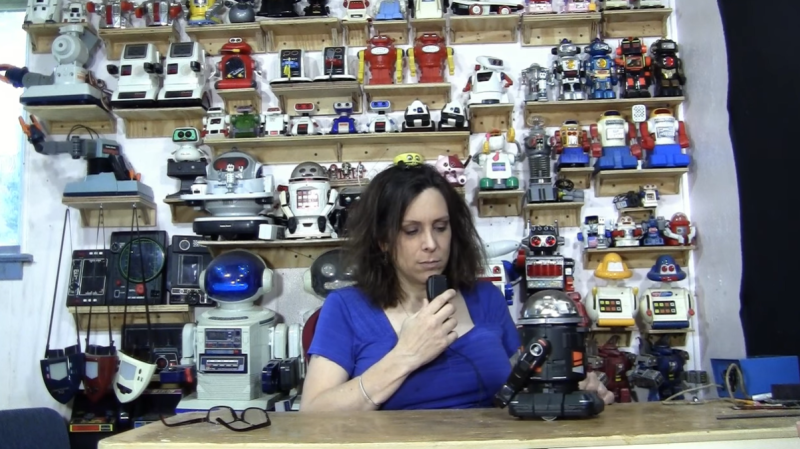What happens to old, neglected 1980s toy robots? According to the [Randi Rain], they turn to the dark side! Way back in the ’80s, Tomy had an entire line of robots — from keychain wind-up toys to rolling, talking machines almost 2 feet tall. Tucked into the middle of this line was Verbot. Verbot’s claim to fame is that it is a voice-controlled robot. More than that, it was speaker-dependent. Train the robot with commands like “go forward” and then watch as it responds to your every command.
As you might guess, the speech recognition wasn’t great by today’s standards. Recognition was handled by a Microcontroller — a Mitsubishi product that was possibly a mask programmed 8051 variant. Pretty novel for an 80s toy — in fact, there’s a patent for it.

The real magic in Verbot is in the mechanical design. Verbot could move forward, backward, turn, “talk”, lift, and lower its arms. It did all of that with just one electric motor. [Randi] explains this mechanical magic during her teardown. Verbot used a “Mechanical Interrogator”, which really is a column of planetary gears, cogs, and levers. The device looks like it belongs in a Curta mechanical calculator more than a plastic toy. The whole system works through a clever operation of switches, which inform the microcontroller when a mechanical function is selected. The micro then reverses the motor to perform the operation.
The particular Verbots [Randi] is working on in this video are definitely showing their age. Yellowing, cracked plastic, and other problems had turned them both into basket cases. Rather than go the retrobright route, [Randi] decided to make one evil robot from the two. A coat of black paint, some orange highlights later, she had one working robot that looked more like Darth Vader than a yellowed toy.
[Randi’s] background as a professional propmaker and magician has given her some excellent casting skills. She easily creates resin replacements Verbot’s translucent red eyes and buttons using a silicon mold of the old parts.
The end result of this project is a working, rolling dark side Verbot. This little ‘bot would make an excellent companion for any Dark Trooper!
















The 1790’s to 1990’s had a fair number of single motor/multiple function toys. The Armatron comes to mind, as well.
I would guess the logic to be that molded gears were cheap compared to the electronics and motors. Inexpensive motors were low torque, low efficiency permanent magnet types, and were fairly large by today’s standards. So, one motor and more gears made much more sense than more motors.
Wow. Any examples for us in the early part of that timespan?
Should have been 1970;s. I can type. Releay.
Then again, there were a lot of automata from the 18th century that did mighty complex things, though that wasn’t my intent here.
Tomy was really good at making these mechanical wonders – as you mentioned, Armatron is another one of their designs. I was always curious about the cost differences between mechanical and electronic complexity.
In many cases molded gears are still cheaper to do the job I would suggest, just the design engineering and number of revisions to working hardware with it is no doubt much higher than throwing more tech at it and definitely takes longer to start the mass production (after all the software can be fixed while the factories tool up in theory) so while you might make more money if the toy is really successful with gears if its a flop that is vastly more R&D and product development down the drain.
Also don’t think that sort of gearbox driven rather slow toy would catch on half as well now, its just outcompeted by such impressive virtual robots and the more high end robots you can watch on the internet if not ever own… Perhaps having a pair or trio of those motors with gearbox power divider so you can really get elaborate in the animations would still grab a kids attention, but cute as that guy is for anybody but the budding engineer (who’s parents will let/ fail to prevent) the toy being taken apart its going to get put in a box and forgotten if it gets bought at all…
Multiple motors vs gears: that’s a neat question!
We’ve seen at least a couple projects that are essentially spirographs — the quintessential geared toy — but done instead with stepper motors and tweaking the ratios between them.
https://hackaday.com/2021/12/10/arduino-drives-faux-spirograph/
https://hackaday.com/2014/05/30/art-o-matic-is-spirographs-young-hip-offspring/
Makes sense when it’s easier to do motion control than to get fancy plastic gears injection molded.
But there’s a certain elegance in the one-motor solution as well…. On the other side, there are tons of cool 3DP gear projects that run with one motor or fewer. Greg Zumwalt’s stuff comes to mind, but there’s definitely more.
It’s a rich vein to mine!
Very true, its quite elegant getting so much done with just one motor, but its also quite a limitation to only be able to drive one axis at once and with a significant response time delay.
Though with 3d printers getting so good at small details something like this Verbot can probably be developed much cheaper and easier than the past, so maybe we will see more of these sort of solutions perhaps combining two or three motors with the gearbox splitter to really pack in the extra driveable axis.
Also really worth noting that despite all the old toys I’m aware of doing this having used very small motors you can use this method and have a motor much much larger than the gearbox that shares its power out – the gears are able to take very much higher loads than that piddly dc motor, heck gears of similar material and tooth profie are quite likely inside your drills gearbox, most cheap mini lathes etc… So its probably a good way to pack lots of power into your smaller formfactors, and certainly cheaper than buying many giant high power stepper.
The Armatron was well engineered. Not only with multiple differential gearing but with the torque vs load/friction. Very intricately designed by people who understood the constraints intuitively.
To think, all that complicated gearing and mechanical magic was cheaper than sticking a couple of extra motors in.
Yellowing of older keyboards is because of bromine – a flame retardant usually found in old ABS plastic. Upon long exposure to UV light, the bromine particles in the plastic within started destabilizing, thus appearing yellowish.
To make white again use a 10% hydrogen peroxide cream,, plastic wrap, small paint brush, a UV light and time.
Paint the plastic with the hydrogen peroxide cream, cover with a layer of plastic wrap (to prevent drying) and light up with UV light.
That part of the robot that didn’t yellow was probably in the shade or box. This is why the inside of the robots are still close tot he original color.
however, the discoloring is exactly on the line between the different castings, so there must be a difference between the two
A fascinating video on early automa:
https://www.youtube.com/watch?v=buRMXn6iedE
Love the name. “Verbot” is the German word for “ban”. Perfect fit for a bot which has turned to the dark side.
I actually had a Verbot as a kid. The voice recognition actually worked very well as long as your spoken commands were consistent with the voice used to program the individual actions (speed, pitch, tone, etc). The one annoying thing was the need to reprogram each voice command at each power up. Non-volatile memory was obviously too expensive to use at that time. Still an amazingly advanced toy for the time.